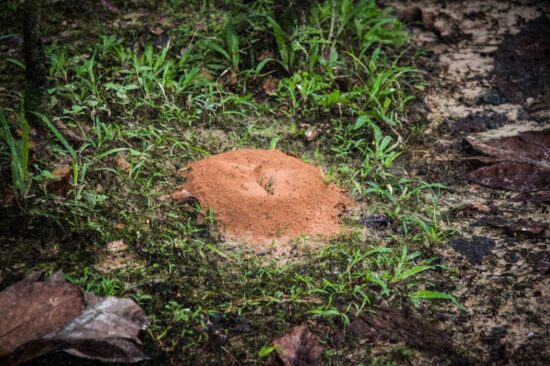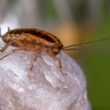Those little dirt mounds popping up all over your yard can be really annoying. Ant hills aren’t just ugly to look at; they’re also a sign that there’s a whole colony of ants living underground. If you want to learn how to get rid of ant hills for good, you need to know that just knocking over the mound won’t work. You have to eliminate the queen ant to stop the whole colony.
Getting rid of ant hills can be tricky, but there are lots of different ways to tackle the problem. Some methods are natural and safe for kids and pets, while others use stronger chemicals for tougher situations. The key is finding the right approach for your specific ant problem.
1. Flood Them Out with Your Garden Hose
One of the simplest ways to deal with ant hills is to flood them with water from your garden hose. This method works by making the ants think their home isn’t safe anymore, so they’ll pack up and move somewhere else.
To try this method, put your garden hose right next to the ant hill and let it run for about 5 minutes. Keep going until you see water starting to pool around the area. The water will collapse the ant tunnels and force the ants to relocate.
This approach works best if you don’t mind the ants moving to another part of your yard. It’s also safer than using chemicals, especially if you have kids or pets playing outside. You might need to flood the same hill a few times before the ants get the message and leave for good.
Adding a squirt of dish soap to the water can make this method even better. The soap helps the water get deeper into the tunnels and makes it harder for ants to survive.
- Attracts and kills ants you see and the colony you don’t
- Fast results—see fewer ants in just days
- Ready-to-use stations, no mess or setup needed
- Perfect for kitchens, bathrooms, and any ant hotspots
2. Pour Boiling Water on the Hill
If you want quick results and don’t mind killing the ants, boiling water is one of the fastest ways to handle an ant hill. The hot water kills ants instantly and destroys their tunnel system at the same time.
Fill up your biggest pot or kettle with water and bring it to a rolling boil. Once it’s ready, carefully carry it outside and pour it directly over the ant hill. The heat will kill any ants it touches and collapse their tunnels.
This method works great for small to medium-sized hills when you need immediate results. However, it might not reach ants that are deep underground, and those survivors could rebuild the colony later. Also, be careful not to pour boiling water on your grass or plants because it will kill them too.
You’ll probably need to repeat this process a few times to make sure you get all the ants. It’s also important to work quickly because the water cools down fast once you’re outside.
3. Mix Boiling Water with Dish Soap
Taking the boiling water method one step further, you can add dish soap to make it even more effective. The soap helps the hot water penetrate deeper into the ant colony and makes it harder for ants to escape.
Start by boiling a large pot of water on your stove. Once it’s bubbling, stir in about one cup of biodegradable liquid dish soap. Mix it well, then carefully take the mixture outside and pour it over the ant hill.
The soap works by breaking down the surface tension of the water, which helps it flow better through the ant tunnels. It also makes it nearly impossible for ants to swim or float, so they’ll drown even if the heat doesn’t get them first.
This combination is more effective than plain boiling water, but you still need to be careful around your plants and grass. The soap mixture can harm vegetation just like plain hot water, so aim carefully and only use it on the ant hills themselves.
4. Sprinkle Food Grade Diatomaceous Earth
- Kills fleas, ants, roaches, and more
- Includes powder duster for easy, targeted application
- Works indoors and outdoors, long-lasting when dry
- 100% pure, food-grade, safe around pets and kids
Diatomaceous earth is a natural powder made from tiny fossilized sea creatures. When ants walk through it, the powder sticks to their bodies and dries them out, which eventually kills them. It’s one of the safer options for getting rid of ant hills when you have children or pets around.
Make sure you buy food-grade diatomaceous earth, not the kind used for pool filters. Sprinkle it generously around the ant hill and the area where you see ants walking. The powder works slowly, so you’ll need to be patient.
One downside to this method is that it stops working when it gets wet. If it rains or you water your garden, you’ll need to reapply the powder. Also, be careful not to breathe in the dust when you’re spreading it around.
Even though diatomaceous earth is natural, it can still irritate your lungs if you inhale it. Wear a dust mask when applying it, and keep kids and pets away until the powder settles.
5. Make a Borax and Sugar Bait
This homemade bait is one of the most effective ways to eliminate an entire ant colony, including the queen. The sugar attracts the ants, and they carry the mixture back to their nest where it kills the whole colony.
Mix two cups of sugar with one cup of water and two tablespoons of borax in a bowl. Stir it until everything dissolves, then put small amounts of the mixture in shallow containers around the ant hills.
The trick to making this work is getting the mixture just right. Too much borax will scare the ants away, but too little won’t kill the colony. The recipe above usually works well, but you might need to adjust it if the ants aren’t taking the bait.
This method takes time to work. You might not see results for several days or even weeks because the ants need time to carry enough bait back to the colony. Keep the bait containers away from children and pets because borax can be harmful if they eat it.
6. Use Store Bought Granular Ant Baits
- Attracts and kills ants you see and the colony you don’t
- Fast results—see fewer ants in just days
- Ready-to-use stations, no mess or setup needed
- Perfect for kitchens, bathrooms, and any ant hotspots
Commercial ant baits like Amdro or Terro take the guesswork out of mixing your own bait. These products are specifically designed to attract ants and eliminate entire colonies, including the queen.
Most granular baits work for months after you apply them, and they can kill more than 20 different types of ants. Sprinkle the granules in a band around your property or directly around problem ant hills.
The best time to apply these baits is during cool weather or in the early morning and evening when ants are most active. Don’t put them out when it’s raining or when rain is expected because water will wash the bait away.
One application can protect your yard for up to three months, making this a convenient option for busy homeowners. Just follow the directions on the package and be patient while the bait does its work.
7. Try Professional Strength Insecticide Drench
For serious ant problems, professional-grade insecticides like Supreme IT can provide the strongest results. These products contain bifenthrin, which is very effective against many types of ants and lasts for a long time.
Mix one teaspoon of the insecticide with one gallon of water, then use one to two gallons of this mixture to drench each ant hill. Pour the solution over the mound and about four feet around it to make sure you get the whole colony.
The best time to apply this treatment is in the late evening or early morning when most ants are inside the nest resting. This timing gives you the best chance of reaching the queen and eliminating the entire colony.
This method works faster than baits and can eliminate an ant hill within hours. However, these are strong chemicals, so follow all safety instructions on the label and keep children and pets away from treated areas.
8. Use Fire Ant Specific Treatments
If you’re dealing with fire ants, you need special products designed just for them. Fire ants are more aggressive than regular ants, and their stings can be painful and dangerous.
Products like Ortho Fire Ant Killer are made specifically for these tough ants. Apply about two-thirds of a cup over each fire ant mound and the area about three feet around it. Then drench the whole area with two gallons of water.
These treatments work fast, often killing fire ant colonies within 15 minutes. Some products also prevent new mounds from forming for up to six months, which saves you time and effort later.
Always apply fire ant treatments during cooler weather, ideally between 65 and 80 degrees. Fire ants are most active during these temperatures, so you’re more likely to get them all in one treatment.
9. Use the Two Step Method for Fire Ants
When you have lots of fire ant hills in your yard, the two-step method is the most effective approach. This combines broadcasting bait over your entire yard with treating individual problem mounds.
Start by spreading fire ant bait over your whole lawn sometime between late August and mid-October. The worker ants will take this bait back to their colonies where it will kill the queens and stop reproduction.
For the second step, treat any remaining problem mounds with a drench treatment or granular fire ant killer. This combination approach can reduce the number of fire ant mounds in your yard by 80 to 90 percent.
The timing is important for this method to work well. Fall application lets the bait work over winter while you’re spending less time outside. You’ll need to repeat the bait application once or twice each year to keep fire ants under control.
10. Apply Liquid Mound Drench Treatments
Liquid drenches are the fastest way to eliminate individual ant hills. When applied correctly, they can kill an entire colony within just a few hours.
Mix the liquid insecticide according to the package directions, then pour it directly over the ant hill. Use enough liquid to completely soak the mound, which usually takes one to two gallons depending on the size of the hill.
The key to success with this method is using enough liquid to reach all parts of the colony. Many people don’t use enough, which lets some ants escape to rebuild somewhere else. Don’t disturb the mound before treating it, or the ants might move the queen to safety.
These treatments work much faster than baits, making them perfect when you need to eliminate a problem mound quickly. However, they only work on the hills you can see, so smaller colonies might still be hiding nearby.
11. Apply Insecticide Dust to Ant Hills
Insecticide dusts are finely ground powders that stick to ants when they walk through them. The ants carry the dust back to their nest, where it spreads to other ants and eventually kills the whole colony.
This method works well for ant hills in hard-to-reach places like cracks in sidewalks or tight spaces between buildings. You don’t need to add water, and the dust keeps working for a long time after you apply it.
Sprinkle the dust directly over the ant hill and the area around it. Be careful on windy days because the dust can blow around and affect other insects or contaminate water sources.
Keep children and pets away from treated areas because the dust can be harmful if they breathe it in or get it on their skin. Some insecticide dusts have a strong smell that can linger for weeks, especially those containing acephate.
12. Try Coffee Grounds as a Natural Deterrent
Used coffee grounds are a popular natural method for dealing with ant hills. The caffeine in coffee affects ants’ nervous systems, and the strong smell disrupts their ability to communicate with each other.
Sprinkle fresh coffee grounds directly on ant hills and around areas where you see ants walking. This method won’t kill the ants, but it should encourage them to move somewhere else.
The downside to using coffee grounds is that ants are smart enough to simply move the grounds out of their way or find a new path around them. You’ll also have coffee grounds sitting on your yard, which some people find messy.
While many people swear by this method, scientific evidence is limited. It might work as a temporary deterrent, but don’t expect it to solve a serious ant problem on its own.
13. Create Barriers with Cinnamon and Spices
Strong-smelling spices like cinnamon, cayenne pepper, and black pepper can help repel ants from certain areas. These spices irritate ants and disrupt the scent trails they use to navigate.
Sprinkle ground cinnamon or other spices around ant hills and along the paths where ants travel. You can also use whole cinnamon sticks if you prefer.
This method is very safe around children and pets, and the spices won’t harm your plants or grass. However, it’s more of a deterrent than a killer, so it works better for keeping ants away than eliminating existing colonies.
For better results, combine spices with other natural methods. The spices alone probably won’t solve a major ant problem, but they can be part of a larger strategy for getting rid of ant hills.
14. Use Essential Oils to Disrupt Ant Colonies
Essential oils like peppermint, tea tree, and cinnamon oil have strong scents that overwhelm the chemical trails ants use to find food and communicate. These oils create barriers that ants prefer to avoid.
Mix five drops of tea tree oil with one cup of water in a spray bottle. Spray this mixture around ant hills and other areas where you see ant activity. You can also soak cotton balls with the oil and place them near problem areas.
Research has shown that cinnamon leaf essential oil can be effective for both killing and repelling ants. However, essential oils need to be reapplied frequently because their scent fades quickly, especially outdoors.
This method is safer than chemical pesticides and smells much better too. Just remember that some essential oils can be harmful to pets, so check with your vet before using them if you have cats or dogs.
15. Spread Cornmeal Around Ant Hills
Cornmeal is an interesting natural approach to ant control. Ants are attracted to cornmeal and will eat it, but their bodies can’t digest it properly, which eventually leads to their death.
Spread cornmeal generously around ant hills and anywhere you see evidence of ant colonies. The ants will either eat the cornmeal right away or carry it back to their nest to share with other ants.
This method is completely safe around children and pets, making it a good choice for families. However, it takes much longer to work than chemical treatments, so you’ll need to be patient.
Some people are skeptical about whether cornmeal actually works, but many homeowners report good results with this method. Since it’s safe and inexpensive, it’s worth trying if you prefer natural solutions for getting rid of ant hills.




